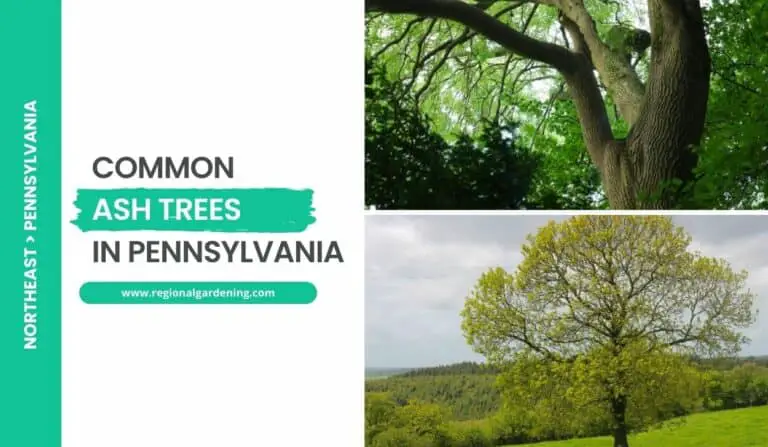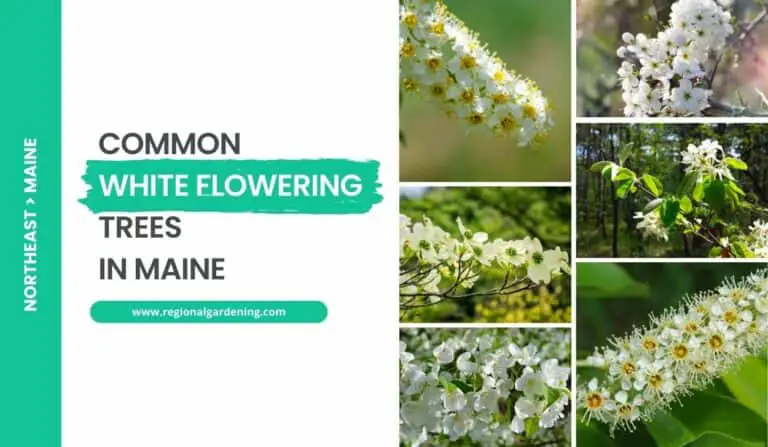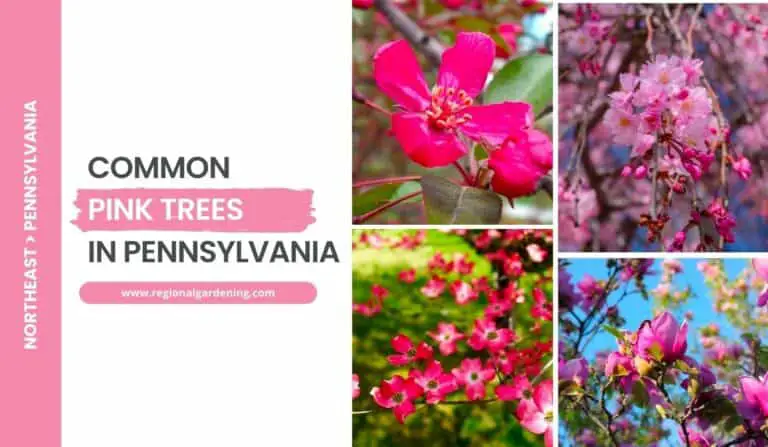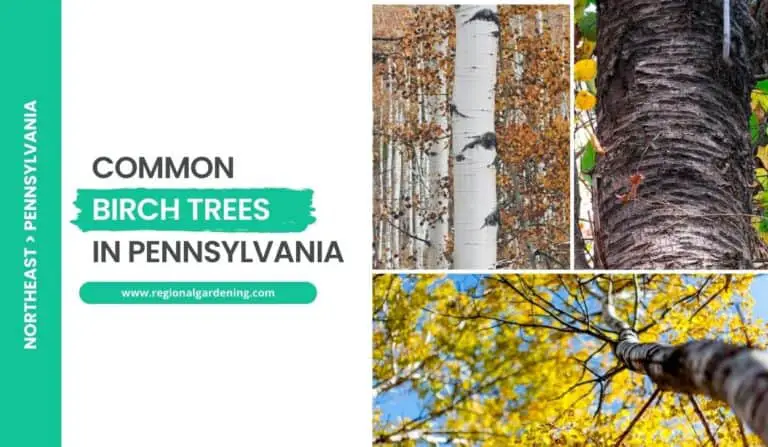6 Common Nut Trees In Pennsylvania (Photos & Identification)

Pennsylvania has a diverse range of natural beauty, with its lush forests and rolling hills. Nut trees thrive in this environment, providing not only aesthetic appeal but also a bounty of delicious and nutritious nuts.
Pennsylvania is a nut enthusiast’s paradise, from the majestic black walnut tree with its sought-after wood and flavorful nuts to the sturdy hickory tree with its durable wood and wildlife-attracting nuts.
In this article, we will look at nut trees in Pennsylvania, including native species, their preferred habitats, and the benefits they provide to both humans and wildlife.
So, let’s begin.
1. Black Walnut
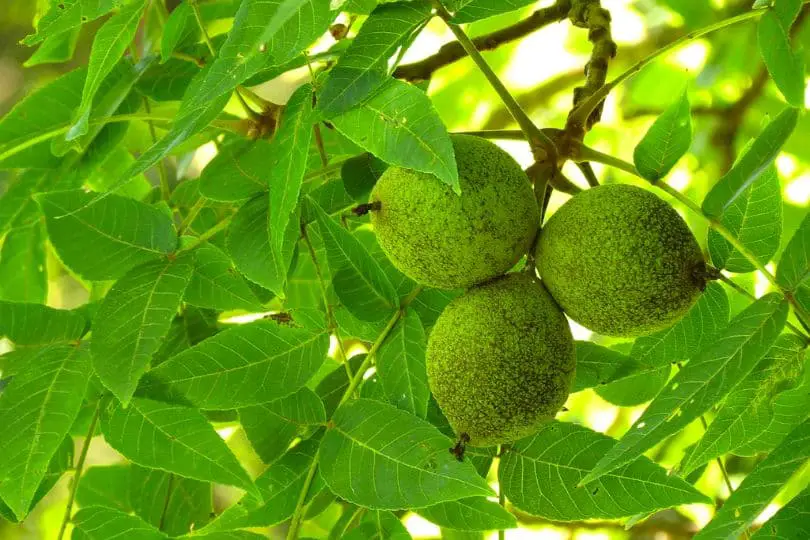
- Scientific Name: Juglans nigra L.
- Common Name(s): Black Walnut
- Mature Height: 70-100 feet (21-30 meters)
- Native Region: North America
- Flowers: Green catkins that appear with the unfolding leaves
- Fruit: Round nut, 1-2 inches in diameter, with a thick green spongy husk and a sweet, oily kernel
- Uses: The rich brown heartwood is highly valued for veneer and quality furniture, gun stocks, and musical instruments. The oil-rich nuts are used in baked goods and feed many species of squirrels and other small mammals.
The Black Walnut (Juglans nigra L.) is one of the most commonly found native nut trees in Pennsylvania. It is a huge tree that can grow to heights of 70-100 feet (21-30 meters).
The Black Walnut’s leaves are compound and alternating, with 15 to 23 leaflets. Each leaflet is 3-4 inches long, small-toothed, and hairy on the underside. When crushed, the leaves exude a spicy aroma from the primary leaf stem.
The Black Walnut twigs are thick and orange-brown to dark brown in hue. They are roughened and easily shattered by huge leaf scars. The buds are gray and downy, with 14 inch side buds and a bigger end bud.
The Black Walnut produces drooping green catkins of flowers in the spring, which appear alongside the unfolding leaves. These catkins can also be seen on the butternut tree. The resulting fruit is a 1-2 inch round nut with a tough shell covered by a thick, almost smooth, green spongy husk. The nut’s kernel is both delicious and oily.
The dark brown heartwood of the Black Walnut is highly valued for veneer and quality furniture, gun stocks, and musical instruments. Furthermore, the Black Walnut’s nuts are oil-rich and have culinary use in baked foods. They also provide food for many squirrel and other small mammal species.
Care should be taken in Pennsylvania landscapes to provide appropriate room for the Black Walnut, as it takes a large area to grow to its maximum size. The tree grows well in rich limestone soils. Regular trimming may be required to keep its shape and avoid overgrowth. Furthermore, the husks of the nuts can stain hands and clothing, so use caution when handling them.
2. American Beech
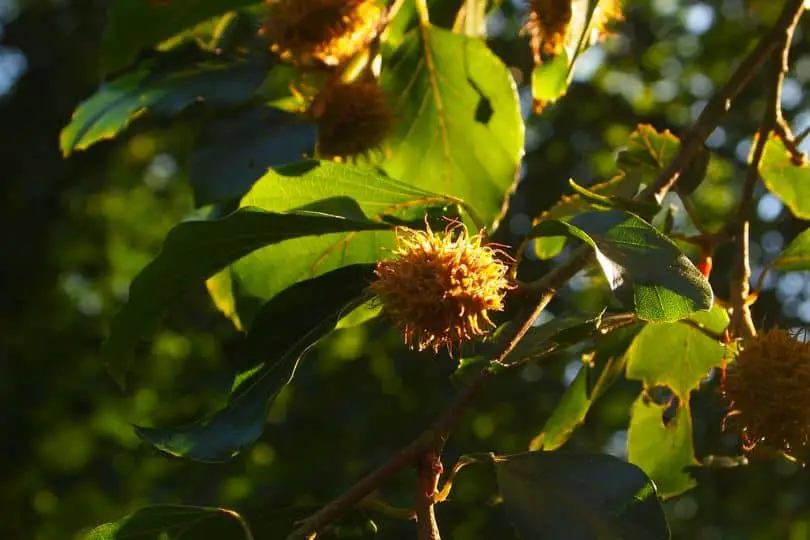
- Scientific Name: Fagus grandifolia Ehrh.
- Common Name(s): American Beech
- Mature Height: 50′-60′ (15-18 meters)
- Native Region: North America
- Flowers: No Flowers
- Fruit: Triangular, pale brown, shining nuts
- Uses: The American Beech is an important timber species and provides food for wildlife such as bears, squirrels, turkeys, and grouse. It is also commonly planted for shade in large open areas such as parks and golf courses.
The American Beech, scientifically known as Fagus grandifolia, is a North American deciduous tree. It can be found across Pennsylvania, particularly in moist and rich soils, though it is more common in the state’s northern parts. The American Beech, with mature heights ranging from 50 to 60 feet (15 to 18 meters), is a magnificent shade tree that may lend charm to wide open areas such as parks and golf courses.
The physical qualities of this tree are distinct. It has alternating, plain leaves with a strong leathery feel. They are around 3 to 4 inches long with strongly serrated margins. The upper surface of the leaf is light green and glossy, while the underside is yellow-green. The twigs of the American Beech are slender, hairy at first, then smooth with a zigzag pattern. This tree’s buds are long and slender, with a sharp point and covered in reddish-brown scales.
The fruit of the American Beech is a stalked, thorny 4-valved bur. Triangular and pale brown nuts can be found within these burs. These nuts, sometimes known as beechnuts, are a significant source of food for many wildlife species, including bears, squirrels, turkeys, and grouse.
The American Beech thrives in damp and rich soils, according to Pennsylvania landscape care tips. It prefers well-drained soil but may grow in a variety of soil types. During dry conditions, regular watering is required to maintain optimal health. To shape the tree and remove any dead or damaged limbs, prune in late winter or early spring. Mulching around the tree can help keep moisture in and weeds out.
Pennsylvania residents value the American Beech for its wood and wildlife benefits. It is a significant timber species because of the great quality of its wood, which is often used for furniture, cabinetry, flooring, and veneer. The nuts produced by the American Beech are an important food source for a variety of species, ensuring their survival and adding to the region’s general biodiversity.
3. American Chestnut
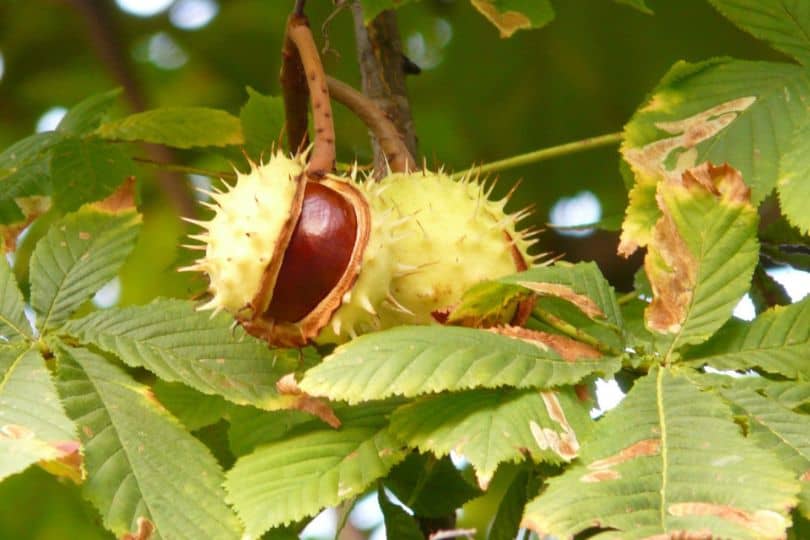
- Scientific Name: Castanea dentata (Marshall) Borkhaussen
- Common Name(s): American Chestnut
- Mature Height: 80-100 feet (24-30 meters)
- Native Region: North America
- Flowers: No flowers.
- Fruit: Prickly bur 2″-3″ across, containing 2-3 shiny brown, sweet, and edible nuts.
- Uses: The American Chestnut was once the most common and valuable tree in Pennsylvania valued for both its wood and nuts. The wood was highly sought after for its durability and resistance to decay, making it ideal for building materials and furniture. The nuts were a valuable food source for both humans and wildlife.
The American Chestnut (Castanea dentata) is one of the tallest nut trees in Pennsylvania that once dominated Pennsylvania’s woodlands. With a straight trunk and a broad, spreading crown, it can reach heights of 80 to 100 feet.
The leaves of the American Chestnut are alternating, simple, and range in length from 5 to 11 inches. They have hooked, sharply pointed teeth on the borders and sharply pointed points. The leaves’ upper and lower surfaces are smooth.
The twigs of the American Chestnut are thick and smooth, with a greenish to brown coloration. They have a lot of little, elevated, white lenticels. The fruit of the American Chestnut is a 2 to 3 inch wide thorny bur. Each bur contains 2 to 3 lustrous brown, delicious, and edible nuts. One side of the nuts has been flattened.
Unfortunately, the American Chestnut population has been severely impacted by chestnut blight, a bark disease. The illness destroyed the species, and it now exists only as stump sprouts and little trees. Attempts are being made to breed resistance to chestnut blight from the resistant Chinese chestnut (Castanea mollissima). These breeding operations aim to introduce resistance into the American Chestnut population.
The American Chestnut is prized in Pennsylvania landscapes for its historical and ecological significance. While mature American Chestnut trees are becoming increasingly scarce as a result of the plague, there are still relics that provide a glimpse of the old forest landscape.
Because of its endurance, the wood is highly valued in speciality woodworking, such as furniture and cabinetry. The nuts, which are no longer as plentiful as they once were, are nonetheless valued as a local delicacy and feed wildlife. Restoration efforts are ongoing, and the American Chestnut has a unique place in the hearts of Pennsylvanians as a symbol of their natural history.
4. Hazelnut
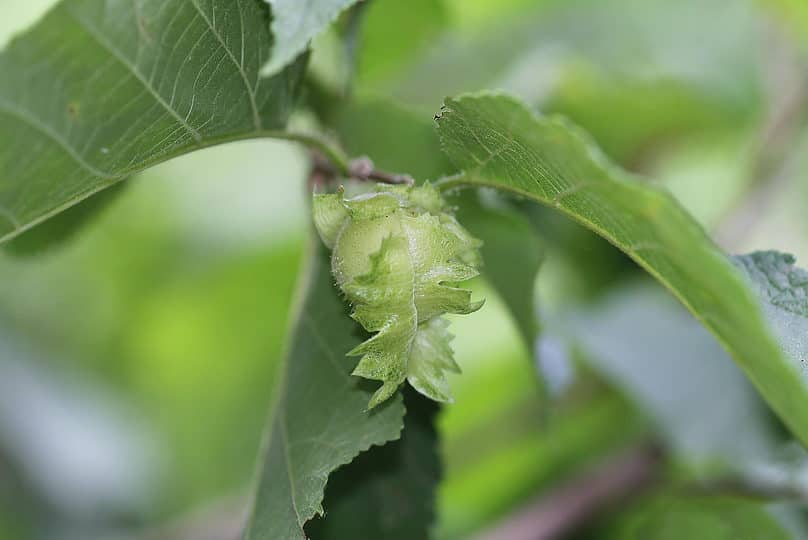
- Scientific Name: Corylus avellana
- Common Name(s): Hazelnut, Filbert
- Mature Height: 10-15 feet (3-4.5 meters)
- Native Region: Europe and Western Asia
- Flowers: Yellowish catkins in early spring
- Fruit: Small edible nuts enclosed in a husk
- Uses: Hazelnuts are commonly used for culinary purposes, including cooking and baking. They are also popular for snacking, and the oil extracted from hazelnuts is used in various beauty and skincare products.
Hazelnut trees (Corylus avellana) are small deciduous trees that normally develop to a height of 10 to 15 feet. They are native to Europe and Western Asia, but they have been widely planted in many areas, including Pennsylvania. Hazelnut tree leaves are round or oval in form, with a serrated edge and a bright green color. The bark is grayish-brown in hue and smooth.
In early April, hazelnut trees produce yellowish catkin flowers that are not extremely spectacular but are beneficial to pollinators. The flowering period is followed by the formation of little edible nuts encased in a husk. These round or oval-shaped nuts, often known as hazelnuts or filberts, have a sweet and nutty flavor.
Hazelnut trees flourish in well-drained soil and like full sun or partial shade in Pennsylvania landscapes. Once grown, they require little maintenance and are drought tolerant. Watering regularly during dry seasons and mulching at the base of the tree can help retain moisture.
The nuts produced by hazelnut trees have a wide range of applications in Pennsylvania. Locals frequently munch on them, bake with them, or incorporate them into various recipes. Hazelnut oil is derived from the nuts and is used in cooking as well as cosmetics and skincare items. The tree is also regarded for its decorative properties, which offer visual appeal and shade to landscapes.
5. Butternut
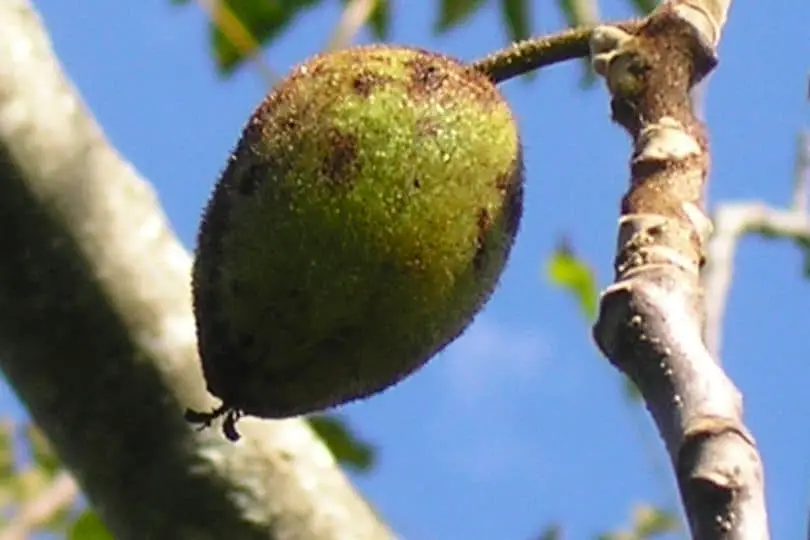
- Scientific Name: Juglans cinerea L.
- Common Name(s): Butternut, White Walnut
- Mature Height: Up to 60 feet (18 meters)
- Native Region: North America
- Flowers: No Flowers
- Fruit: An oblong nut, 1½”-2½” long, covered with a hairy, sticky husk. The rough nutshell is pointed at one end, and the kernel is oily and sweet.
- Uses: The wood of the Butternut tree is primarily used for furniture, instrument cases, and boxes. The nuts are also an important food source for wildlife.
The Butternut tree (Juglans cinerea L.) is a medium-sized tree that may grow to heights of up to 60 feet (18 meters). When compared to its sibling, the Black Walnut, it is more usually found in rich bottom lands and on lush hillsides, with a higher concentration in northern tier counties and at higher elevations. White Walnut is another name for the Butternut tree.
The Butternut tree’s leaves are alternating and complex, with 11 to 17 leaflets. Each leaflet is 3–5 inches long and has tiny teeth. The leaves’ upper surface is dark yellow-green, while the lower surface is lighter and hairy. The tree is one of the last to sprout leaves in the spring and one of the first to shed them in the autumn.
Butternut tree twigs are sturdy and greenish-gray to tan in hue. They have a brittle and gritty feel. The twig pith is chocolate-brown and chambered. The buds are light brown, hairy, and lack scales. The end bud is 12 to 34 inches long, while the side buds are smaller. Between the leaf scar and the bud, there is a fringe of small hairs.
The Butternut tree’s fruit is an oval nut that measures 112 to 212 inches long. It has a hairy, sticky husk covering it. The rough nutshell is pointed on one end, and the oily and tasty kernel inside.
The Butternut tree is appreciated in Pennsylvania landscapes for its wood, which is mostly used for furniture, instrument cases, and boxes. The tree’s nuts are also an important food source for wildlife. It should be mentioned, however, that a fungal disease has afflicted many Butternut trees throughout their range, causing major population declines.
6. Pecan
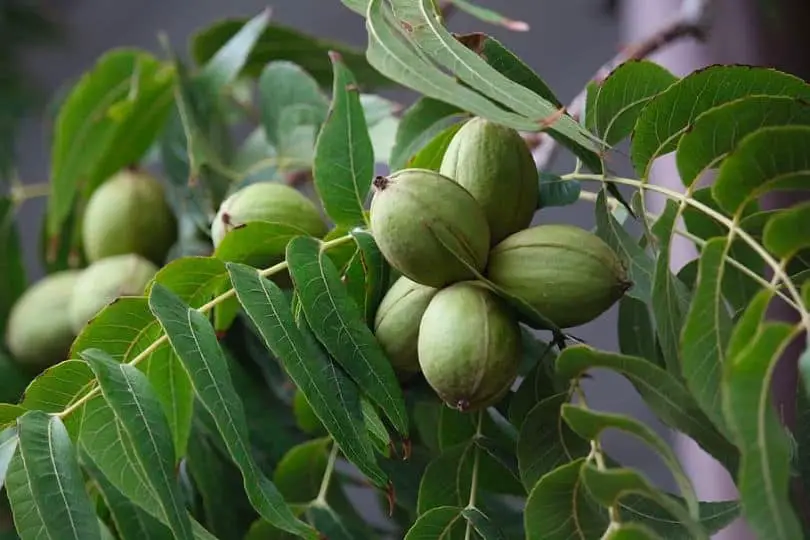
- Scientific Name: Carya illinoinensis
- Common Name(s): Pecan
- Mature Height: 70-100 feet (21-30 meters)
- Native Region: North America
- Flowers: Male flowers are elongated and yellow-green, while female flowers are small and reddish.
- Fruit: The fruit is a hard-shelled nut with a thin outer husk. The nuts are elongated and have a sweet and rich flavor.
- Uses: Pecan trees are grown primarily for their edible nuts, which are used in various culinary applications such as baking, cooking, and snacking. The wood from pecan trees is also used in furniture making and woodworking.
Pecan trees are huge deciduous trees that can grow to be 70 to 100 feet tall. They have a broad canopy and pinnately complex leaves with 9 to 17 leaflets. When the tree is young, the bark is light gray and smooth, but as it ages, it becomes rough and scaly.
Pecan trees are native to North America, mainly the southern United States, and have adapted well to the environment of Pennsylvania. They prefer full sunlight and well-drained soil. Pecan trees are prevalent along riverbanks and in bottomland woods.
Pecan trees produce little, elongated male flowers called catkins and small scarlet female flowers in late April. Female flowers mature into nuts, each encased in a thin husk. Pecans are gathered in the fall for their sweet and rich-flavored nuts.
It is critical to provide regular irrigation to pecan trees in Pennsylvania, especially during drought years. To keep the tree’s shape and eliminate any dead or diseased branches, prune during the dormant season. To promote optimal nut production, pecan trees may require additional fertilizing.
Pecans are widely used in Pennsylvania for a variety of culinary uses. They are utilized in the preparation of pies, cookies, and cakes, as well as savory dishes such as pecan-crusted poultry and salads. Woodworkers use pecan wood to make furniture, flooring, and other decorative things because of its attractive grain. Pecans are also a popular snack that may be eaten on its own or mixed with trail mixes and granola.
Similar Articles
- Common Flowering Trees In Pennsylvania
- Common Maple Trees In Pennsylvania
- Common Cherry Trees In Pennsylvania
- Common Pine Trees In Pennsylvania
- Native Locust Trees In Pennsylvania
- Common Cedar Trees In Pennsylvania
- Common Palm Trees In Pennsylvania
- Common Birch Trees In Pennsylvania
- Common Aspen Trees In Pennsylvania
- Common Oak Trees In Pennsylvania
- Common Ash Trees In Pennsylvania
- Common Elm Trees In Pennsylvania
- Common Spruce Trees In Pennsylvania
- Pink Flowering Trees In Pennsylvania
- White Flowering Trees In Pennsylvania
- Purple Flowering Trees In Pennsylvania
Common Nut Trees In Pennsylvania – Sources
The Regional Gardening team makes sure that the information in our articles is accurate by only using sources that are known to be trustworthy. Some of these sources are peer-reviewed journals from government agencies, well-known universities, and scientific research organizations.
- Native Plant Resources, Pennsylvania Native Plant Society
- Trees & Shrubs Varieties, PennState Extension
- Landscaping With Natives, Pennsylvania Department Of Conservation, & Natural Resources
- Explore Pennsylvania Forests, Pennsylvania Department Of Conservation, & Natural Resources


